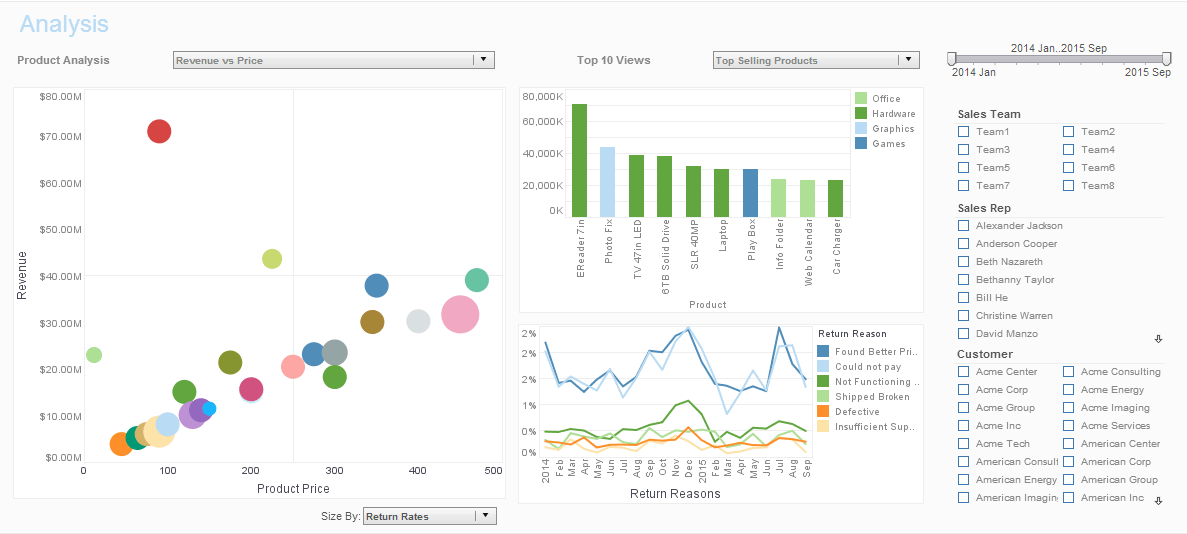InetSoft Webinar: Compare Traditional BI Versus Future BI
This is the continuation of the transcript of a Webinar hosted by InetSoft on the topic of "Why You Need Data Discovery Software." The speaker is Abhishek Gupta, product manager at InetSoft.
Now let’s compare traditional BI versus future BI. BI has always been something that’s had a steep learning curve. It’s certainly gotten better over the years as the BI vendors have made their tools a little bit easier to get results faster. But there is a learning curve, and IT has to run the show because it’s about the data access, access to the data stores that must be carefully managed.
As I mentioned before we’re moving from an age of the data getting in, to more of the data getting out. And so there is a new kind of balance that’s needs to be achieved there. Future BI would increase self-service BI, put more technology in the hands of users to personalize their experience with access and analytics.
Moving again from static reports, limited data visualization options to tools that really are focused on the idea of graphical data visualization had much more data interactivity without having to involve IT.
Now they can drill down into information, and I think these are the kinds of the things that non-technical users need. They need the graphical ability because obviously many users, particularly when they have to make quick operational decisions can respond more effectively to charge, to dashboard kind of information.
But at the same time that can’t be all there is. There’s got to be an ability to drill down, to interact with the data, to ask those series of questions that really are hard to anticipate from an IT developer point of view. Limited access to only relational data sources, well now, as I mentioned before there are other kinds of sources, and a lot of these fall into the category of what was called big data which would be a range of structured, unstructured, semi structured, obviously the volumes are getting big out there when we talk about stuff that is available on the internet and the social media.
End users are going to need access to that big data, so again it’s kind of a rebuilding of the tools for data access and analysis to allow for that kind of wider and somewhat deeper range of access. Slow development cycles and requirements gathering, that’s the old world. Now we’re moving into the age where the demand is really for rapid development, greater agility and the ability to meet changes in your requirements.
That’s been a hard thing for IT when they do all the work to get the user requirements done only to sit down with the users to discover the requirements have changed. That’s not uncommon, and research has shown this is one of the number one complaints about enterprise BI. And so we’re looking at tools that can really put more of the controls in the user’s hands, so that we don’t get into that kind of negative cycle with IT.
So enter data discovery and unified information access for nontechnical users. I think the emphasis with both these areas, as I’ve mentioned, is for data discovery. It is really is, or it has been self-service. That’s a key one, and a lot of the capabilities that IT developers could build, but really you’re talking about much longer development cycles. Why not give some of these capabilities to the users themselves if the BI technology can support it.
And so data discovery has been very strong. I think in that area particularly using dashboards so that organizations or users can personalize information access and analysis much faster is great. Deployment, get the systems up running much more quickly, with less IT involvement in the deployment cycle.
Have more visual, more up to date use of graphics, using rich internet kinds of media to support the much larger graphics. And next comes using things like in memory or specialized SQL techniques to improve performance against those large volumes of data or to support the more highly visual environment. So that’s the kind of thing that has characterized the data discovery tools that have come out in recent years.
And then unified information access, this is also an area that I think has been really interesting and has been developed over last three years, coming from different point of origin than data discover. There has been more in search, and from the relational point of view, unstructured data. I think the better term these days is multi structured data.
But in any case you looking at content, a much more interesting usage search is to find the content, building on some of the search technologies. Enterprise search is bringing in the ability to do things like spatial and geographical data analyses, looking at other kinds of sources and gaining intelligence from those sources again for standard users, not for just the expert users in the organization.


